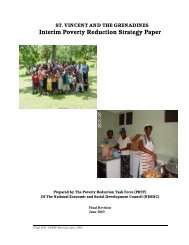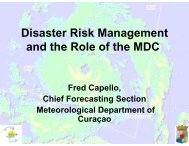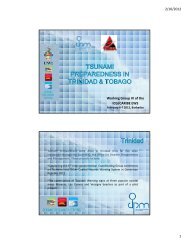The Anatomy of A Silent Crisis The Anatomy of A Silent Crisis
The Anatomy of A Silent Crisis The Anatomy of A Silent Crisis
The Anatomy of A Silent Crisis The Anatomy of A Silent Crisis
- TAGS
- anatomy
- www.bb.undp.org
You also want an ePaper? Increase the reach of your titles
YUMPU automatically turns print PDFs into web optimized ePapers that Google loves.
End notes<br />
99<br />
33. Warner, T. (2004). “Desert Meteorology”. Cambridge<br />
University Press, Cambridge, p.595.<br />
34. Please refer to “Notes on report methodology C.”<br />
35. Maplecr<strong>of</strong>t, (2009) and McCarthy, M. (2008): “Why<br />
Canada is the best haven from climate change.” UK<br />
Independent. July 4. http://www.independent.co.uk/<br />
environment/climate-change/why-canada-is-the-besthaven-from-climate-change-860001.html.<br />
36. Watkins, K. (2007): “Human Develop Report<br />
2007/2008 Fighting climate change: Human solidarity<br />
in a divided world.” United Nations Development<br />
Programme.<br />
37. Ehrhart, C. (2008): “Humanitarian implications <strong>of</strong><br />
climate change mapping emerging trends and risk<br />
hotspots.” CARE, p.2..<br />
38. Government <strong>of</strong> Bangladesh. (2008): “Bangladesh<br />
climate change strategy and action plan.” Government<br />
<strong>of</strong> Bangladesh.<br />
http://www.foshol.org/IUCN_BCCSAP_2008/IUCN_<br />
BCCSAP_2008_part2.pdf.<br />
39. CRED database, (2009).<br />
40. Agrawala, S., et al. (2003) “Development and climate<br />
change in Bangladesh: Focus on coast flooding<br />
and sundarbans.” OECD. http://www.oecd.org/<br />
dataoecd/46/55/21055658.pdf.<br />
41. <strong>The</strong> Equity and Justice Working Group Bangladesh<br />
claims that approximately 30 million people in 19 <strong>of</strong> 64<br />
districts along the southern coastline have already been<br />
exposed to climate change. <strong>The</strong> Inter-governmental<br />
Panel on Climate Change had previously estimated that<br />
about 22 million Bangladeshis would become refugees<br />
due to climate change impacts by 2050.<br />
42. DPA. (2009): “Rights group says 30 million Bangladeshis<br />
exposed to climate change.” EarthTimes, April 4. http://<br />
www.earthtimes.org/mobile/263068.xhtml.<br />
43. World Health Organization Statistical Information<br />
System, (2009).<br />
44. Stern, N., et al. (2006): “Stern Review: <strong>The</strong> Economics<br />
<strong>of</strong> Climate Change.” HM Treasury, Chapter 6, http://<br />
www.hm-treasury.gov.uk/stern_review_report.htm.<br />
45. Please refer to “Notes on report methodology D.”<br />
46. Garnaut, R., et al. (2008): “<strong>The</strong> Garnaut Climate<br />
Change Review.” Cambridge University Press. http://<br />
www.garnautreview.org.au/index.htm#pdf.<br />
47. <strong>The</strong> model is based on an aggregate value for<br />
economic and non-economic losses due to climate<br />
change at a 2.5 degree increase in temperature<br />
compared to pre-industrial times. See “Notes on report<br />
methodology D.” for further description.<br />
48. Fortson, D., (2008). “Stern warns that climate change<br />
is far worse than 2006 estimate.” <strong>The</strong> Independent,<br />
April 17. http://www.independent.co.uk/news/<br />
business/news/stern-warns-that-climate-change-is-farworse-than-2006-estimate-810488.html.<br />
49. CIA World Factbook, (2008 values).<br />
50. OECD. (2008): “Development Aid at its highest level ever<br />
in 2008.” OECD. http://www.oecd.org/document/35/0,<br />
3343,en_2649_34487_42458595_1_1_1_1,00.html.<br />
51. Felix, A. (2008): “Experts predicts Afro-Asian trade to<br />
exceed USD 100 billion by 2010.”<br />
IPP Media, June 13. http://www.ippmedia.com/ipp/<br />
guardian/2008/06/13/116387.html.<br />
52. WRI. (2009): “Annual Adaptation Costs in Developing<br />
Countries.” World Resources Institute. http://www.<br />
wri.org/chart/annual-adaptation-costs-developingcountries.<br />
53. Estimated using Geary-Khamis International<br />
commodity price weights for 2000/2001.<br />
Approximately $200 US dollar value per tonne was<br />
assumed based on weighted average <strong>of</strong> key crops<br />
including: Maize, Rice, Wheat, Barley, Rye, Buckwheat,<br />
Rapeseed, Soybean, Sunflower, etc.<br />
54. Telleen-Lawton, T. (2009): “Hotter fields, lower yields<br />
how global warming could hurt America’s farms.”<br />
Environment America Research and Policy Center, April.<br />
55. World Resources Institute Earth Trends (2003) states<br />
that cereal production in South Africa and Sub-<br />
Saharan constitute 40% <strong>of</strong> total agricultural production,<br />
with remainder including roots and tubers, pulses and<br />
meat. International commodity unit prices (2001-2003)<br />
for cattle: US $1,183 and cow milk: US $269.







